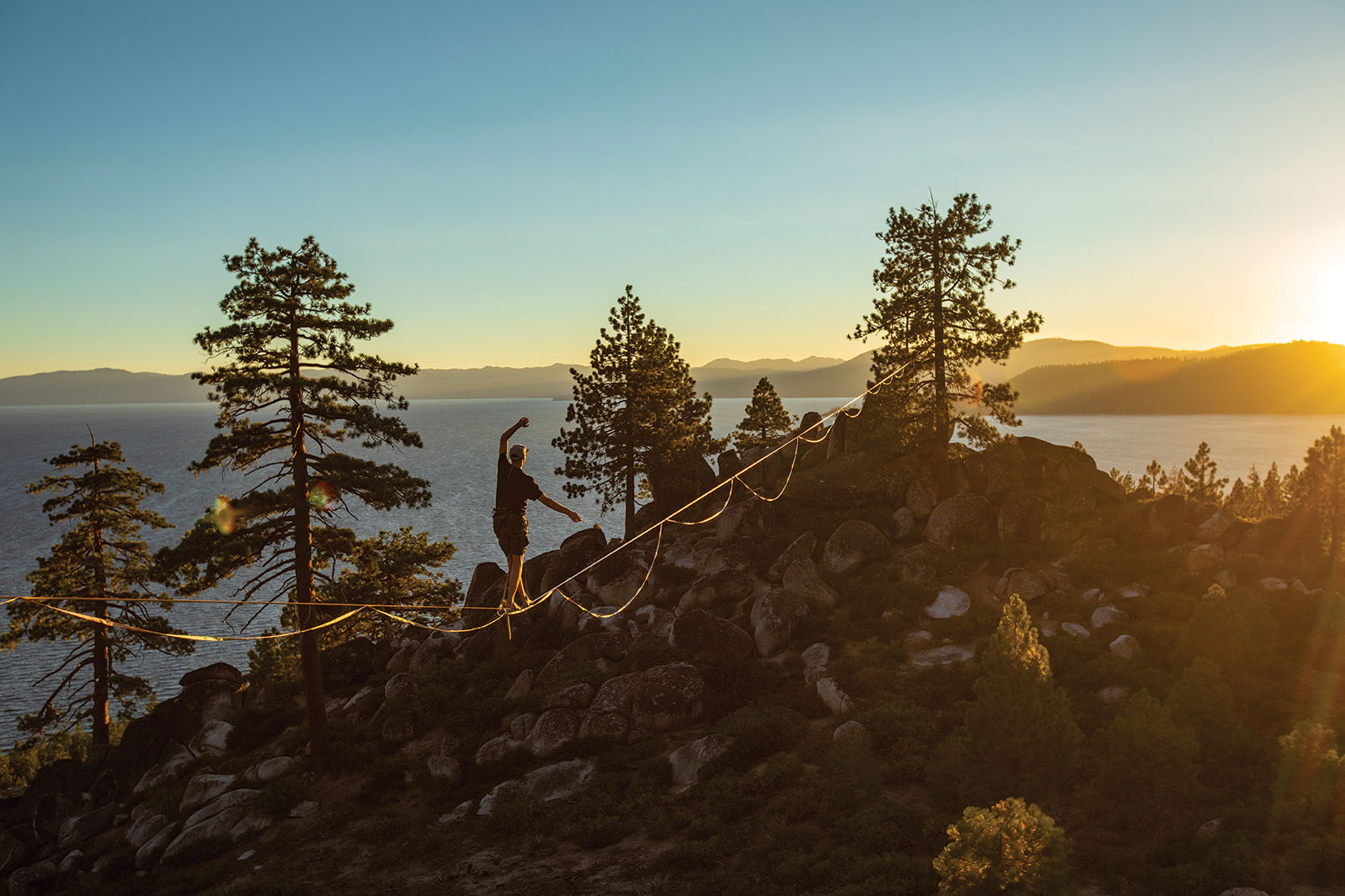
24 Sep Walking a Fine Line
The simple challenge of balancing across a thin piece of webbing has become an act of defiance, an obsession, a quest for community and a dangerous search for the outer limits of a sport
It’s not easy to make sense of the evolutionary imperative that compels one to try to cheat death, or at least the illusion of death. Since the dawn of conscious thought, there have always been those who see life as a game worth playing only when the stakes are high, but historically they have been cast to the fringes of the human experience. Out there, they formed itinerant tribes, ragtag troupes, dirtbag caravans; they sought epiphany in caves, before crowds, at Burning Man.
But the divide between the salaried status quo and the free thinkers on the fringe narrows with each generation. Today, they and their antics occupy feature-length articles, Oscar-winning documentaries, Super Bowl halftime shows.
Still, the question remains: What compels a human to try to cheat death, or at least the illusion of it?
For Dominic Soufl, the 23-year-old leading the next generation of Tahoe highliners, the answer is less academic and more experiential.
“It’s hard for people who don’t understand it,” he says. “The more extreme a sport is, the more compelling emotionally it is. When you’re about to get on a highline, you’re shaking, you think you’re going to kill yourself, you’re so scared. It’s not until you stand up that you’re like, ‘This is why I’m doing it.’”
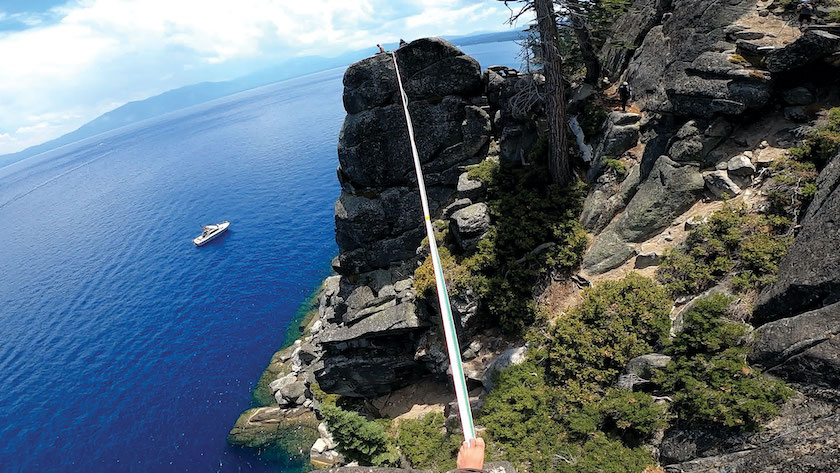
A highline with a view at D.L. Bliss State Park, photo by Anthony Cupaiuolo/First Tracks Productions
birth of a sport
In its current form, slacklining only dates back about 40 years. The spirit of the fledgling sport, however, has existed as long as there have been wayward youth to look at narrow, improbable surfaces and think, “I can balance on that.”
At its most fundamental, then, slacklining is the act of balancing on an unlikely surface. At its most existential, slacklining is an elegant answer to the question: What am I made of?
This same question compelled two young rock climbers in the early 1980s to look at their loose pieces of webbing and see more than just casual accessories. In the Yosemite climbing scene of that era, climbers were known to balance on parking lot chains in between sessions on a rock face. Adam Grosowsky and Jeff Ellington found the activity absorbing but limiting. To recreate the challenge with the added value of mobility, the two repurposed their carabiners and climbing webbing—a woven material typically used for slings, harnesses and anchor extensions—to create the ideal balancing act: a line with enough tensile strength to support weight (more than 4,000 pounds, at minimum), and enough flexibility to engage the muscles and the mind.
Not for the first time in California’s history, a new sport was born.
Within just months of its inception, disciples of the budding sport began to push the boundaries. In 1985, Scott Balcom, a peer of Grosowsky and Ellington, successfully walked the first highline crossing of Lost Arrow Spire, the detached pillar in Yosemite that rises 3,000 feet off the valley floor. The four-minute video of his accomplishment is tinged with nostalgia, in part because the grainy camcorder footage is a portal to a time before peddlers of energy drinks and mounted bodycams convinced us that life must be lived on camera—preferably multiple cameras, and definitely in high definition—and in part because the accomplishment itself would soon be rendered as quaint as the first human to break the four-minute mile.
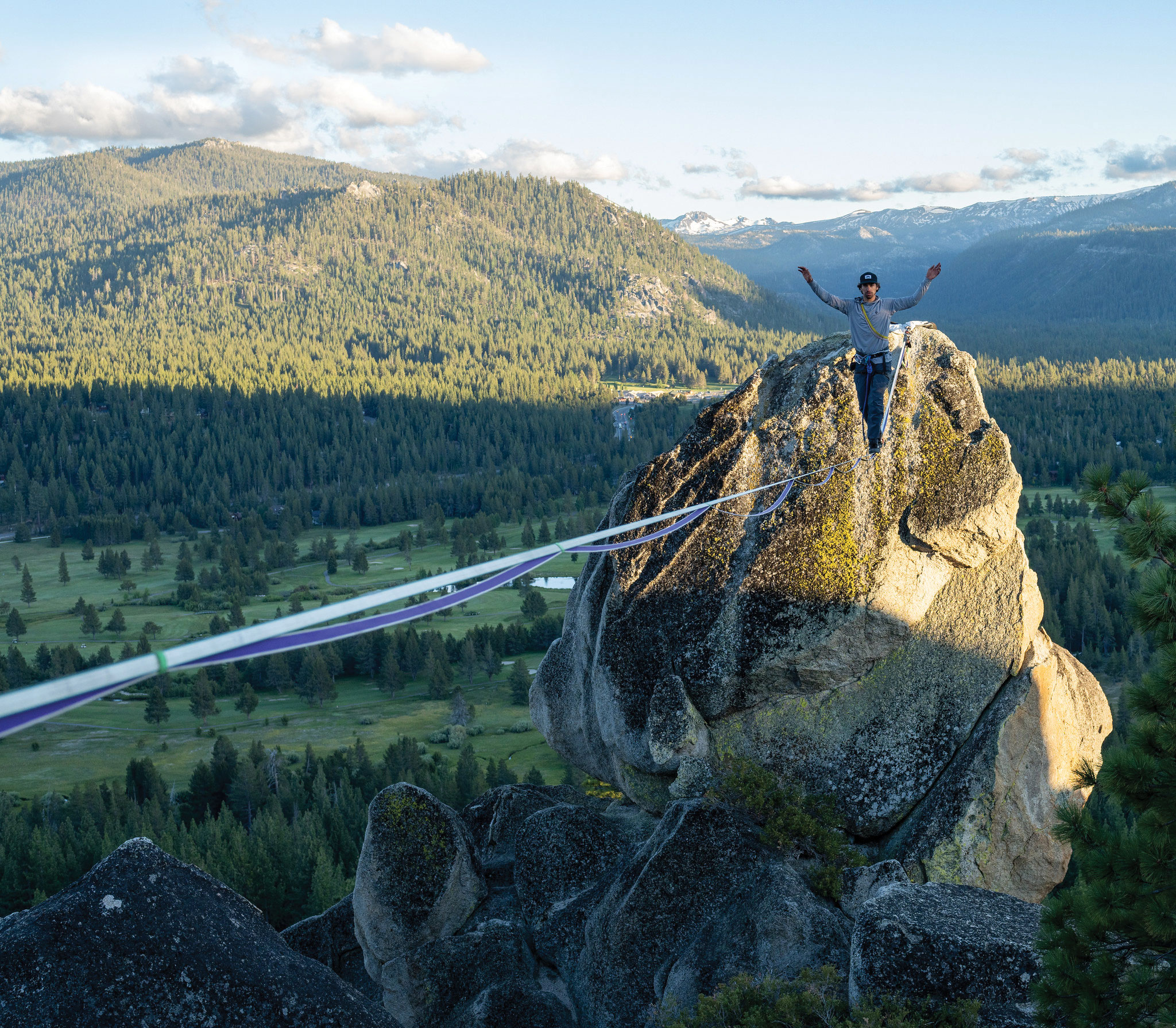
Dominic Soufl walks a highline at Pie Shop near Tahoe’s South Shore, photo by Anthony Cupaiuolo/First Tracks Productions
Staring Down into the Void
Since that inaugural walk 35 years ago, Lost Arrow Spire has become one of the most iconic highline destinations for pilgrims of the slackline community. It has been repeated thousands of times, both on-leash, in which the walker is tethered to the line by a harness and a short piece of webbing, and off-leash, a death-defying act known as free-soloing.
Soufl has never free-soloed, nor has he walked Lost Arrow Spire, but, like an avatar of the entire sport of slacklining itself, his skill and hunger have outpaced his temperance. He expects to test himself in Yosemite within a year.
For now, he is content to rig and walk highlines around Tahoe, including D.L. Bliss State Park, where a nearly 100-foot line stretches above the West Shore; the iconic Lover’s Leap, the site of a 57-foot span; and Pie Shop, a 65-foot walk above the popular climbing and bouldering rock formation off of Sawmill Road.
Soufl has slacklined extensively throughout South Lake Tahoe, but these three lines are special to him. D.L. Bliss is his first love, the one that changed him. Before D.L. Bliss, Soufl was a disaffected youth from Redondo Beach, a skater who gave the middle finger to high school in search of something more meaningful. After his senior year, the 18-year-old determined that skating and smoking weed were not the pinnacles of meaning, and he decided to kickstart his dream of aerospace engineering in Tahoe, as much to escape the burnout crowd in Redondo as for the highly rated community college.
It was there that he discovered an aptitude for math and science, as well as a knack for rock climbing, a sport he tried for the first time as a college elective his sophomore year. Climbing opened the door to the Tahoe Basin, and Soufl devoted more time to his new favorite hobby.
Later that year, a friend of a roommate crashed at the house Soufl shared with two others in South Lake Tahoe. The guest was an avid slackliner, and as a way to say thank you to his weekend hosts, he invited them to join him at D.L. Bliss for a session on the slackline. It was to be the first time Soufl ever set foot on a line, but there was one little caveat: The line was rigged 100 feet off the ground.
The traditional newbie narrative goes like this:
You see someone slacklining in a park or in a climbing gym. Maybe a buddy has a setup and convinces you to give it a try. You put your weight on the line, feel the thin fabric underfoot. You grab hold of a tree branch, or a buddy’s shoulder, or the corner of the climbing wall. You lift your hand free and—just as you feel that equanimity of perfect balance—the line twists and you fall to the ground, a little shaken up, a little embarrassed. Days pass, and you are haunted by the feeling of failure and the hunger for perfect balance. You buy a length of webbing and some carabiners at REI and anchor it in your backyard for the entire summer, and every single day you go back there and practice until you no longer need the tree branch or your buddy’s shoulder; until you no longer fall to the ground. You set up a new line, a little longer, a little higher. You practice turns and jumps; you walk with your eyes closed; you walk backwards.
When that’s no longer enough, you hit up a guy on Instagram who rigs lines between cliffs. You meet him and a few others that weekend, and when it’s your turn you step into your harness, clip your 6-foot safety leash into the line, and place one trembling foot over the chasm. Your body feels the urge to defecate, urinate and vomit all at the same time. The fear is tantalizing, and you step out into space.
Most of Soufl’s first year in the sport followed this common narrative. What is uncommon is the fact that the first slackline he ever walked was a highline. He started where most people end, staring down into the void.
“I had just been introduced to climbing at the time and I thought it was one of the coolest things ever,” says Soufl. “And then I was shown highlining and I was like, ‘Holy crap!’”
As a climber, Soufl understood the systems that make highlining possible: the webbing, the knots, the pulleys, the bomb-proof anchors, the redundancies, the environment itself. That’s where the similarities ended that day at D.L. Bliss.
“If you know the systems are good, there’s really nothing holding you back but the fear,” he says. “It really wasn’t hard to put yourself on the system, but it was hard to step off the edge of the cliff.”
But he stepped off the edge. And fell. His leash held him, and he dangled there in the void, feeling the failure and the fear and the excitement.
“I was so inspired,” he says.
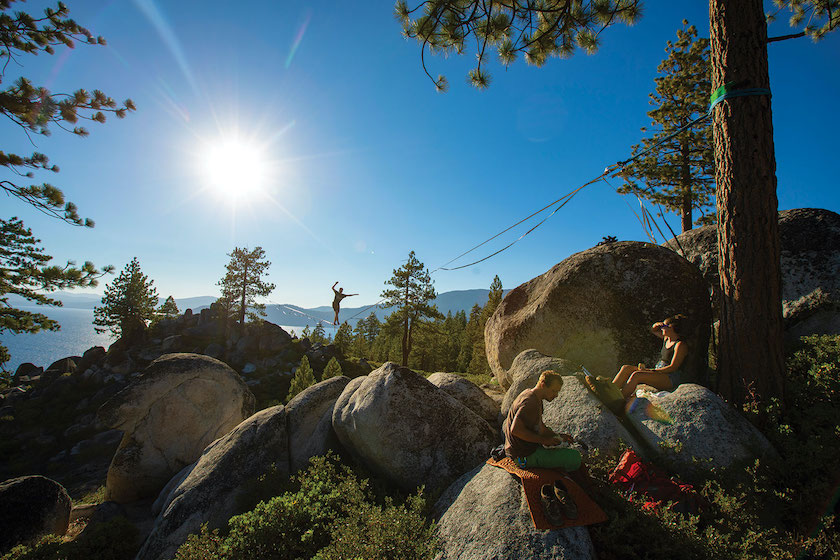
Sara Wilson and Tracy Houser kick back and enjoy a snack and cold beer as Clynton Hébert balances his way across the line, photo by Ryan Salm
A Sport and a Family
Sara Wilson and Clynton Hébert understand that inspiration.
For the Reno-based couple, the sport of slacklining is the sum of everything they love about this region: wilderness, adrenaline and community. Hébert is a competitive skydiver, a juggler and a highline walker. Wilson speaks fondly of “trifecta days,” when she and her friends go mountain biking, skiing and slacklining in one day.
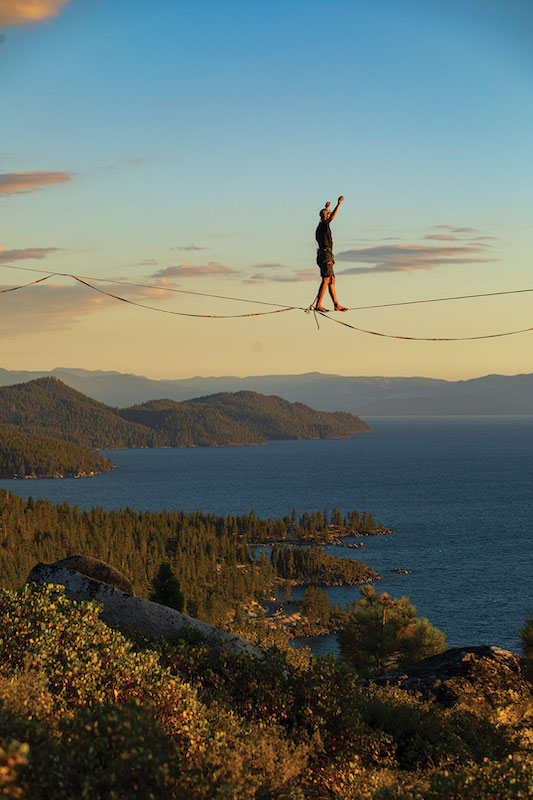
Clynton Hébert walks a highline at sunset above Lake Tahoe’s East Shore, photo by Ryan Salm
They both discovered slacklining in the typical ways—she observed it at a park in Sacramento, he tagged along with some friends for a session at Rainbow Bridge on Donner Summit. But their discovery of each other was less typical. For them, the stars aligned over a wood cabin off of Sky Tavern Road during Hébert’s 30th birthday party, a month-long Kerouacian debauch where slacklining was the least radical activity amid festivities that included launching partygoers into trees with a pulley system and a person brave or drunk enough to jump from the second-story roof as a counterweight.
“Our community is based on gatherings,” says Wilson.
The evidence is unassailable. This past July, they hosted their fourth annual slackline gathering of friends along a small alpine lake north of Truckee. Nominally, the event is to celebrate Wilson’s birthday, but she admits it is less about her and more about those who come to enjoy the waterlines and the densely woven rope and paracord platforms over water known as spacenets. And the kegs of beer.
“We put on these festivals and we get people involved and we meet new friends and we create this community with our love and passion for the sport,” Hébert says. “People are drawn to it.”
For Wilson and Hébert, the community is as attractive as the sport itself—inseparable from it, in fact. While it is true that the couple keep a loose practice line in their living room to stay balanced, it is also true that the sense of balance the sport provides applies not just to fast-twitch muscles and mental acuity, but to social and emotional well-being, too.
“I definitely dealt with a lot of depression and anxiety when I was younger, and I was always searching for that community and not really finding what I was looking for,” says Wilson.
When she discovered slacklining, she found what she was looking for.
“It’s such an inclusive environment because slacklining is such a hard learning curve,” she says. “We can all look at those beginners who can’t take a step and completely relate. I don’t know a single person who was able to just walk a long line without practice. So, if you’re a cool, welcoming person who is compassionate and kind, then you’re all in.
“It sounds cheesy, but we are all a family,” she adds. “I would drop anything for so many people who live here and do whatever is necessary to help them, if needed.”
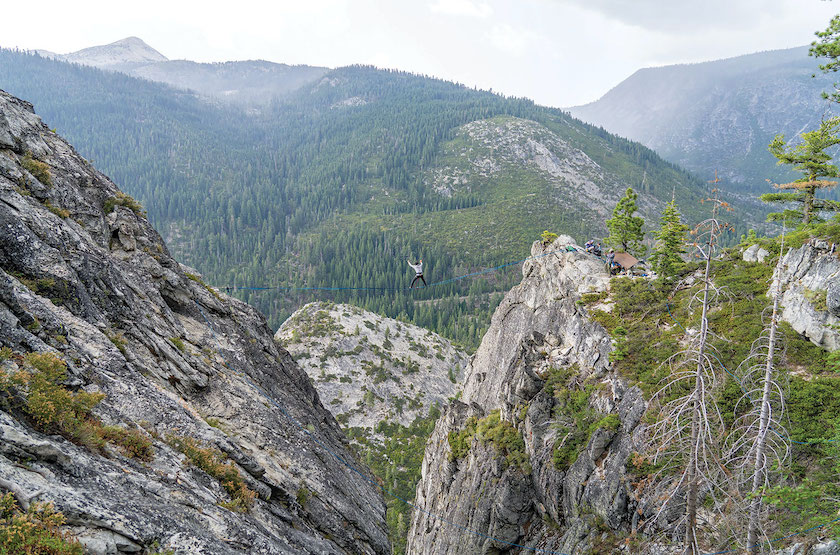
Dominic Soufl balances on a 57-foot span at Lover’s Leap, photo by Anthony Cupaiuolo/First Tracks Productions
Evolving on the Highline
This sense of community is not endemic only to those who bring slacklines to house parties and lakeside retreats. It is also at the core of those who push the boundaries of experience. For Soufl, community has been integral to his evolution as a highliner.
“You’re watching each other dangle over the abyss. It’s really weird how quickly it brings people together,” he says.
If D.L. Bliss is the line that gave him a new hobby, Lover’s Leap is the line that gave him a new family. After his mind-bending first experience 100 feet above the earth, Soufl surrendered to the gravitational pull that is slacklining, a planet capable of pulling into lifelong orbit all wanderers, strays and castaways who search for a sense of meaning that is at once deeply personal and inevitably communal.
While standing alone on an inch-wide line seems like a solitary activity, it is the individual act of radical introspection that draws together kindred spirits. It is one of the paradoxes of slacklining: being alone together makes the solitude deeper and the relationships richer. It is how Soufl and his roommate bonded, and it is how Soufl accepted the baton from the generation before him.
“I was really looking for a highlining mentor, because I knew from climbing experience that even if you think you know what you’re doing, you really need to go out with someone who knows what they’re doing firsthand,” Soufl says.
The man he found was once a polestar of the local highline scene but had since given it up for his wife and unborn child. Though he still climbs regularly, Elias Tinseth has almost completely sworn off highlining.
“That chapter is closed,” Tinseth says. But when Soufl reached out to him asking for mentorship, Elias agreed.
“Dominic and his friends are the next generation,” he says. “Seeing Dominic get into it brought me back to that feeling of when I was getting into it: that drive, how exciting it was, the adventure of it all.”
Tinseth took Soufl and a few others to Lover’s Leap, where they rigged Soufl’s highline 400 feet off the ground. Soufl was a quick study. He filmed and photographed everything, asked questions, participated in the rigging.
“Elias changed my life,” he says.
Within weeks, Soufl rigged the same line at Lover’s Leap without his mentor. Soon after that, he established his own line above the boulders at Pie Shop.
“He really impressed me with how quick he picked up highlining,” Tinseth says. “Anyone who has that drive for a goal, they’re going to achieve that goal and want to push it to the next goal.”
While that observation is certainly true of Soufl’s frenzied evolution in the sport, it is also an apt summary of Tinseth’s own past. Like Soufl, he was a climber who discovered slacklining. Like Soufl, the initial sense of failure consumed him, an obsession that deepened as he excelled. Unlike Soufl, however, Tinseth has given it all up.
“I got bored with the sport,” he says.
Repercussions of the Sport
Slackliners are like sharks—to keep moving is to live. Soufl is a testament to this, his skill and hunger like a time-lapse of flowers blooming.
“When you first get into [slacklining], you don’t even know anything about it, but you see it and you think, ‘I have to do that,’” Soufl says. “Once you do it, you think: ‘I’m finally here and it feels so good… What’s next?’”
Even Wilson and Hébert, for whom the sport is as much a party as it is an activity, are obsessed with growth. For all his quips about being the laid-back “slack-dad” of the local scene, Hébert once walked 300 meters over Cosumnes River Gorge in Placerville and still hungers for adrenal excellence. For all her emotive declarations about family and community, Wilson trains five days a week in the summer so she can one day walk a 300-foot waterline.
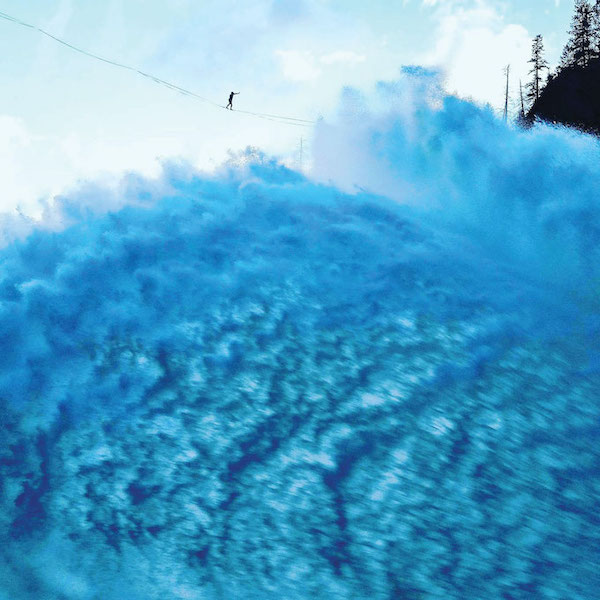
Nick Honnold walks a highline above Silver Creek, a tributary of the South Fork American River, photo by Scott Clifton
The same was true for Tinseth. When he got bored with slacklining on the ground, he tried highlining. When he got bored with highlining, he took the next step: free-soloing. Twice in his life, he stepped out of his harness and walked unprotected over the chasm. To fall would be to die; to walk and not fall would be to live more intently than most can imagine.
“In the moment, walking without protection was a state of euphoria that I can’t even explain,” Tinseth says.
The more he thought about the risks, however, the less comfortable he became. Tinseth believes cheating death is like robbing a bank. You might get away with it, but it’s still unethical. You also might die.
“I felt it was a very selfish thing,” he says. “It’s kind of unfair to everyone who loves you.”
For Tinseth, that includes his partner and the baby she is carrying. He decided to quit free-soloing. In slacklining, as in life, regression is a form of decay, so it was not long before the spirit of the sport withered and died. He still has his highline equipment somewhere, though.
“I always threaten to go set one up with the friends, but I never get around to it,” he says, his recent jaunt on Soufl’s line notwithstanding. But his memories persist. “[Free-soloing] is dangerous, it can’t be guaranteed, and it’s not worth it,” he says. “But it was quite the feeling.”
It is a feeling Soufl wonders about. Even with a safety leash, to walk any highline is to hack into your own brain and battle the illusion of death. It is like playing Russian roulette with an empty gun: perfectly harmless until you change one variable. Soufl wonders how far he will let himself go, and if he will be capable of making an informed decision once he gets there.
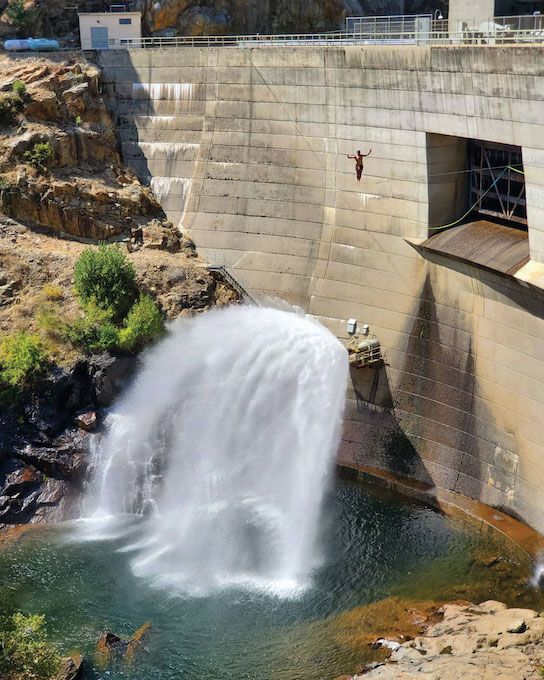
Nick Honnold has been known to free-solo highlines, photo by Michael Flanagan
Tinseth knows firsthand: “It can be addictive. People who keep pursuing it don’t really worry about what they have to lose. Their only goal is chasing that adrenaline, that borderline spiritual state of mind.”
Soufl wonders how far he will chase that feeling. “The fear is part of the reason you enjoy it so much. I’ve always wondered, does that feeling get stronger with less protection? And that’s a scary question.”
“You know you shouldn’t free-solo,” he adds. “If you free-solo and die it would devastate people and they would look at you like an idiot. But if you do it right, you can show that you’re so in control that you can ride that line and not cross over to the other side.”
Riding that line is right where Nick Honnold of Placerville likes to be. His obsession with highlining—and with free-soloing those highlines—proves that his cousin, Alex, who famously climbed Yosemite’s El Capitan without ropes, is not the only Honnold to push boundaries.
“I like to take things to their logical extreme,” Honnold says, explaining how his childhood yo-yo obsession, BMX phase and now free-soloing are all facets of this same character trait. “I have a rather addictive personality.”
While he agrees with Tinseth, his friend and former highline partner, that highlining is addictive, he disagrees that the risks are prohibitive.
“Perhaps I am more selfish about my desires and goals than Eli is. At the end of the day I really only have an obligation toward myself,” Honnold says. “I feel like I have an obligation to come home to people, but I also have an obligation to fulfill myself in ways I see fit.”
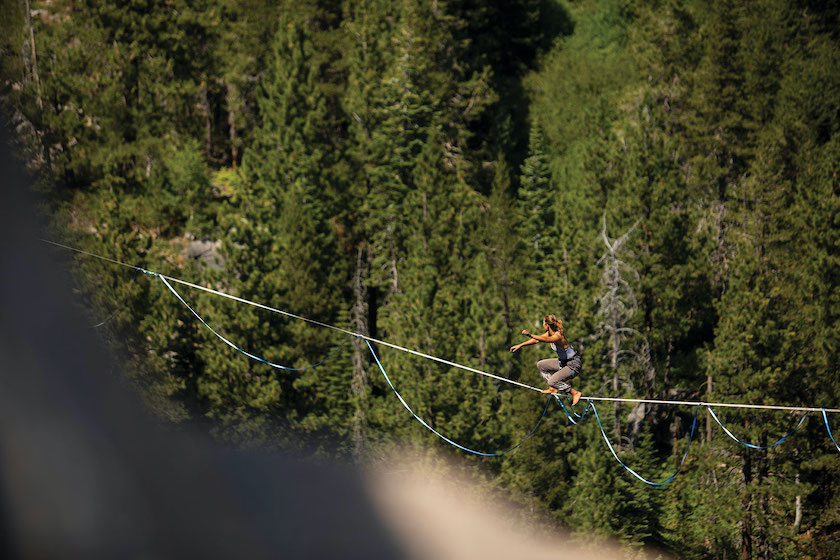
Kristen Gershkoff shows off her skills on a 220-foot line on Donner Summit, photo by Ryan Salm
A Boom in a Fringe Sport
Forty years ago, a few men figured out how to rig webbing between trees and walk on it. Today, men and women around the world are setting slackline records that defy belief. The longest line ever walked is well over a mile; alpine lines span mountain peaks over dizzying drops; free-solo attempts increase in drama and danger every year.
And the community is only expanding. What was once a stunt for radicals on the fringe of society has become a sport for anyone who wants to develop balance and core strength; anyone who seeks profound interactions with Mother Nature and fellow humans; anyone who wants to approach the void and find the illusion of death, or death itself.
Jerry Miszweski, a record-setting slackline legend and owner of Balance Community, has been selling slacklining gear for the last 11 years. The first two years yielded no profit. The next three to five years yielded just enough to live well below the poverty line. Only recently has he been able to sell enough gear to earn “a livable wage.”
Sales continues to grow this year. Since the COVID-19 pandemic, all the time he would normally invest in research and development has instead been spent packing, shipping and dealing with new customers.
“We’re getting way more sales,” he says. “People are feeling a strong urge to go outside.”
The urge to go outside with a slackline just might lead to an urge for more. From that urge a hunger is born that is not easily satisfied.
Soufl knows. Though he plans to transfer this fall to UC Davis to continue his pursuit of aerospace engineering, there are dreams lurking beneath what he refers to as “a regular career lifestyle”—dreams that may prove more intoxicating.
“I would love to be a dirtbag,” he admits. “Buy a van, live out of it, do nothing except climb and highline for the rest of my life. That sounds so spiritually fulfilling.”
Wilson and Hébert know. Right now, they are both, as Hébert sheepishly admits, “gainfully employed”—he is a civil engineer and she is an administrator for the biology department at the University of Nevada, Reno—but they will always straddle the two worlds of Burning Man dirtbag spontaneity and the gainful employment that may better enable them to own a home and start a family.
Tinseth knows. Though he no longer feels passion for the sport, he is still passionate about those who do. Mentoring Soufl and the next generation of Tahoe slackliners reminded him of that. And while he has foresworn free-soloing a highline, he continues to free-solo certain climbing routes. “I’m kind of contradictory about it,” he says.
Honnold knows, perhaps more intimately than almost anyone. Right now, he works for California State Parks, in a role that he describes as “the most pencil-pusher job ever,” but he is perfectly willing to abandon it all.
“I spent two to three years living out of a van and highlining 300 days a year,” he says. “Right now, I feel like I need to put down some roots so I can make adventure easier later in life. But I would have no regrets if a van stumbled into my life and I went back onto the road.”
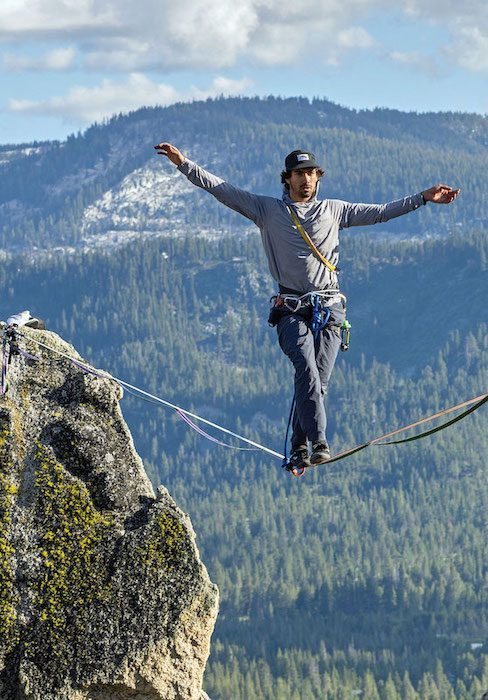
Dominic Soufl at Pie Shop, photo by Anthony Cupaiuolo/First Tracks Productions
Beware the Void
Before Roger Bannister broke the four-minute mile, scientists claimed such a feat was impossible. In 1954, he did what no human had done before. Forty-six days later, somebody beat his time.
When Scott Balcom walked the first highline at Lost Arrow Spire, it shocked the slacklining community. Today, one would have to walk that same line without a safety leash just to raise an eyebrow, and even that has been done already.
The limits of what is possible continue to stretch the imagination, and people like Honnold continue to push it ever outward. They are explorers of the unknown, pilgrims of human audacity. To Honnold, his hunger is a simple reaction to our post-survival society. He wants to feel what the hunters and gatherers of old felt: hard-won meaning.
“What they were engaged in was life or death,” he says. “We’ve reached a point as humans where we’re fairly comfortable. A lot of people are craving more.”
Soufl craves more, as do Hébert and Wilson. Tinseth continues to feel the cravings, too, whether he’s looking back on his highline free-solos or looking forward to his rock climbing free-solos.
You may crave more, too. You may even consider buying a length of webbing and some carabiners at REI. If you do, it may open a world that you never imagined. It may give you a new passion and a new family. It may take you to some of the most beautiful places on earth. But beware the hunger: It may take you out into the void, alone, looking for death, or at least the illusion of it.
If you’re not careful, it just might look back.
Michael Rohm is a freelance writer and humanitarian storyteller based out of Maryland. He gave up slacklining after college but still has a piece of webbing and two perfect pine trees in his backyard. They seem to be calling his name.




Chris
Posted at 22:24h, 30 SeptemberYou know “Man On Wire”?
Scott Balcom is not the first highliner. The sport was not born in California:
On Wednesday, August 7, 1974, people in Lower Manhattan stopped in their tracks to watch a strange event in the sky—a Frenchman named Philippe Petit, was walking on a high wire more than 1,300 feet in the air, suspended between the tops of the Twin Towers of the World Trade Center.